Cervicovaginal Human Papillomavirus Genomes, Microbiota Composition and Cytokine Concentrations in South African Adolescents
Abstract
1. Introduction
2. Materials and Methods
2.1. Study Cohort
2.2. Sample Collection
2.3. Cytokine Measurement
2.4. Extraction of Bacterial Nucleic Acids and 16S rRNA Gene Sequencing
2.5. Extraction of Viral Nucleic Acids
2.6. Viral Metagenome Sequencing and Bioinformatics Analyses
2.7. Whole Community Metagenome Sequencing and Bioinformatics Analyses
2.8. Genome Analyses of HPVs and L1 Phylogeny
2.9. Statistical Analyses
3. Results
3.1. The Eukaryotic Vaginal DNA Virome in South African Adolescents
3.2. HPV Infection Patterns in South African Adolescents
3.3. HPV and the Vaginal Microbiota
3.4. HPV and Cervicovaginal Cytokine Concentrations
4. Discussion
5. Conclusions
Supplementary Materials
Author Contributions
Funding
Institutional Review Board Statement
Informed Consent Statement
Data Availability Statement
Acknowledgments
Conflicts of Interest
References
- Wylie, K.M.; Mihindukulasuriya, K.A.; Zhou, Y.; Sodergren, E.; Storch, G.A.; Weinstock, G.M. Metagenomic Analysis of Double-Stranded DNA Viruses in Healthy Adults. BMC Biol. 2014, 12, 71. [Google Scholar] [CrossRef] [PubMed]
- Jakobsen, R.R.; Haahr, T.; Humaidan, P.; Jensen, J.S.; Kot, W.P.; Castro-Mejia, J.L.; Deng, L.; Leser, T.D.; Nielsen, D.S. Characterization of the Vaginal DNA Virome in Health and Dysbiosis. Viruses 2020, 12, 1143. [Google Scholar] [CrossRef] [PubMed]
- Wylie, K.M.; Wylie, T.N.; Cahill, A.G.; Macones, G.A.; Tuuli, M.G.; Stout, M.J. The Vaginal Eukaryotic DNA Virome and Preterm Birth. Am. J. Obstet. Gynecol. 2018, 219, e1–e12. [Google Scholar] [CrossRef] [PubMed]
- Li, F.; Chen, C.; Wei, W.; Wang, Z.; Dai, J.; Hao, L.; Song, L.; Zhang, X.; Zeng, L.; Du, H.; et al. The Metagenome of the Female Upper Reproductive Tract. Gigascience 2018, 7, giy107. [Google Scholar] [CrossRef]
- Eskew, A.M.; Stout, M.J.; Bedrick, B.S.; Riley, J.K.; Omurtag, K.R.; Jimenez, P.T.; Odem, R.R.; Ratts, V.S.; Keller, S.L.; Jungheim, E.S.; et al. Association of the Eukaryotic Vaginal Virome with Prophylactic Antibiotic Exposure and Reproductive Outcomes in a Subfertile Population Undergoing In Vitro Fertilisation: A Prospective Exploratory Study. BJOG 2020, 127, 208–216. [Google Scholar] [CrossRef]
- Schmitt, M.; Depuydt, C.; Benoy, I.; Bogers, J.; Antoine, J.; Arbyn, M.; Pawlita, M.; Group, on behalf of the V.S. Prevalence and Viral Load of 51 Genital Human Papillomavirus Types and Three Subtypes. Int. J. Cancer 2013, 132, 2395–2403. [Google Scholar] [CrossRef]
- Ameur, A.; Meiring, T.L.; Bunikis, I.; Häggqvist, S.; Lindau, C.; Lindberg, J.H.; Gustavsson, I.; Mbulawa, Z.Z.A.; Williamson, A.-L.; Gyllensten, U. Comprehensive Profiling of the Vaginal Microbiome in HIV Positive Women Using Massive Parallel Semiconductor Sequencing. Sci. Rep. 2014, 4, 4398. [Google Scholar] [CrossRef]
- Bogale, A.L.; Belay, N.B.; Medhin, G.; Ali, J.H. Molecular Epidemiology of Human Papillomavirus among HIV Infected Women in Developing Countries: Systematic Review and Meta-Analysis. Virol. J. 2020, 17, 179. [Google Scholar] [CrossRef]
- Liu, G.; Mugo, N.R.; Brown, E.R.; Mgodi, N.M.; Chirenje, Z.M.; Marrazzo, J.M.; Winer, R.L.; Mansoor, L.; Palanee-Phillips, T.; Siva, S.S.; et al. Prevalent Human Papillomavirus Infection Increases the Risk of HIV Acquisition in African Women: Advancing the Argument for Human Papillomavirus Immunization. AIDS 2022, 36, 257–265. [Google Scholar] [CrossRef]
- Karim, S.S.A.; Baxter, C. HIV Incidence Rates in Adolescent Girls and Young Women in Sub-Saharan Africa. Lancet Glob. Health 2019, 7, e1470–e1471. [Google Scholar] [CrossRef]
- Masson, L.; Passmore, J.S.; Liebenberg, L.J.; Werner, L.; Baxter, C.; Arnold, K.B.; Williamson, C.; Little, F.; Mansoor, L.E.; Naranbhai, V.; et al. Genital Inflammation and the Risk of HIV Acquisition in Women. Clin. Infect. Dis. 2015, 61, 260–269. [Google Scholar] [CrossRef]
- Gosmann, C.; Anahtar, M.N.; Handley, S.A.; Farcasanu, M.; Abu-Ali, G.; Bowman, B.A.; Padavattan, N.; Desai, C.; Droit, L.; Moodley, A.; et al. Lactobacillus-Deficient Cervicovaginal Bacterial Communities Are Associated with Increased HIV Acquisition in Young South African Women. Immunity 2017, 46, 29–37. [Google Scholar] [CrossRef]
- Cao, Z.; Sugimura, N.; Burgermeister, E.; Ebert, M.P.; Zuo, T.; Lan, P. The Gut Virome: A New Microbiome Component in Health and Disease. EBioMedicine 2022, 81, 104113. [Google Scholar] [CrossRef]
- Wirusanti, N.I.; Baldridge, M.T.; Harris, V.C. Microbiota Regulation of Viral Infections through Interferon Signaling. Trends. Microbiol. 2022, 30, 778–792. [Google Scholar] [CrossRef]
- McKinnon, L.R.; Achilles, S.L.; Bradshaw, C.S.; Burgener, A.; Crucitti, T.; Fredricks, D.N.; Jaspan, H.B.; Kaul, R.; Kaushic, C.; Klatt, N.; et al. The Evolving Facets of Bacterial Vaginosis: Implications for HIV Transmission. AIDS Res. Hum. Retrovir. 2019, 35, 219–228. [Google Scholar] [CrossRef]
- Brusselaers, N.; Shrestha, S.; van de Wijgert, J.; Verstraelen, H. Vaginal Dysbiosis and the Risk of Human Papillomavirus and Cervical Cancer: Systematic Review and Meta-Analysis. Am. J. Obstet. Gynecol. 2019, 221, 9–18.e8. [Google Scholar] [CrossRef]
- Norenhag, J.; Du, J.; Olovsson, M.; Verstraelen, H.; Engstrand, L.; Brusselaers, N. The Vaginal Microbiota, Human Papillomavirus and Cervical Dysplasia: A Systematic Review and Network Meta-Analysis. BJOG 2020, 127, 171–180. [Google Scholar] [CrossRef]
- Delany-Moretlwe, S.; Kelley, K.F.; James, S.; Scorgie, F.; Subedar, H.; Dlamini, N.R.; Pillay, Y.; Naidoo, N.; Chikandiwa, A.; Rees, H. Human Papillomavirus Vaccine Introduction in South Africa: Implementation Lessons from an Evaluation of the National School-Based Vaccination Campaign. Glob. Health Sci. Pract. 2018, 6, 425–438. [Google Scholar] [CrossRef]
- Gill, K.; Happel, A.-U.; Pidwell, T.; Mendelsohn, A.; Duyver, M.; Johnson, L.; Meyer, L.; Slack, C.; Strode, A.; Mendel, E.; et al. An Open-Label, Randomized Crossover Study to Evaluate the Acceptability and Preference for Contraceptive Options in Female Adolescents, 15 to 19 Years of Age in Cape Town, as a Proxy for HIV Prevention Methods (UChoose). J. Int. AIDS Soc. 2020, 23, e25626. [Google Scholar] [CrossRef]
- Balle, C.; Konstantinus, I.N.; Jaumdally, S.Z.; Havyarimana, E.; Lennard, K.; Esra, R.; Barnabas, S.L.; Happel, A.-U.; Moodie, Z.; Gill, K.; et al. Hormonal Contraception Alters Vaginal Microbiota and Cytokines in South African Adolescents in a Randomized Trial. Nat. Commun. 2020, 11, 5578. [Google Scholar] [CrossRef]
- Konstantinus, I.N.; Balle, C.; Jaumdally, S.Z.; Galmieldien, H.; Pidwell, T.; Masson, L.; Tanko, R.F.; Happel, A.-U.; Sinkala, M.; Myer, L.; et al. Impact of Hormonal Contraceptives on Cervical T-Helper 17 Phenotype and Function in Adolescents: Results from a Randomized, Crossover Study Comparing Long-Acting Injectable Norethisterone Oenanthate (NET-EN), Combined Oral Contraceptive Pills, and Combine. Clin. Infect. Dis. 2019, 71, e76–e87. [Google Scholar] [CrossRef]
- Lewis, D.A.; Uk, F.; Mu, Þ.E.; Steele, L.; Sternberg, M.; Radebe, F.; Lyall, M.; Ballard, R.C.; Paz-Bailey, G. Prevalence and Associations of Genital Ulcer and Urethral Pathogens in Men Presenting with Genital Ulcer Syndrome to Primary Health Care Clinics in South Africa. Sex. Trans. Dis. 2012, 39, 880–885. [Google Scholar] [CrossRef] [PubMed]
- Bolger, A.M.; Lohse, M.; Usadel, B. Trimmomatic: A Flexible Trimmer for Illumina Sequence Data. Bioinformatics 2014, 30, 2114–2120. [Google Scholar] [CrossRef]
- Bankevich, A.; Nurk, S.; Antipov, D.; Gurevich, A.A.; Dvorkin, M.; Kulikov, A.S.; Lesin, V.M.; Nikolenko, S.I.; Pham, S.; Prjibelski, A.D.; et al. SPAdes: A New Genome Assembly Algorithm and Its Applications to Single-Cell Sequencing. J. Comput. Biol. 2012, 19, 455–477. [Google Scholar] [CrossRef]
- Altschul, S.F.; Gish, W.; Miller, W.; Myers, E.W.; Lipman, D.J. Basic Local Alignment Search Tool. J. Mol. Biol. 1990, 215, 403–410. [Google Scholar] [CrossRef]
- Van Doorslaer, K.; Li, Z.; Xirasagar, S.; Maes, P.; Kaminsky, D.; Liou, D.; Sun, Q.; Kaur, R.; Huyen, Y.; McBride, A.A. The Papillomavirus Episteme: A Major Update to the Papillomavirus Sequence Database. Nucleic Acids Res. 2017, 45, D499–D506. [Google Scholar] [CrossRef]
- Happel, A.U.; Balle, C.; Maust, B.S.; Konstantinus, I.N.; Gill, K.; Bekker, L.G.; Froissart, R.; Passmore, J.A.; Karaoz, U.; Varsani, A.; et al. Presence and Persistence of Putative Lytic and Temperate Bacteriophages in Vaginal Metagenomes from South African Adolescents. Viruses 2021, 13, 2341. [Google Scholar] [CrossRef]
- Tisza, M.J.; Belford, A.K.; Domínguez-Huerta, G.; Bolduc, B.; Buck, C.B. Cenote-Taker 2 Democratizes Virus Discovery and Sequence Annotation. Virus Evol. 2021, 7, veaa100. [Google Scholar] [CrossRef]
- Bernard, H.-U.; Burk, R.D.; Chen, Z.; van Doorslaer, K.; zur Hausen, H.; de Villiers, E.-M. Classification of Papillomaviruses (PVs) Based on 189 PV Types and Proposal of Taxonomic Amendments. Virology 2010, 401, 70–79. [Google Scholar] [CrossRef]
- Muhire, B.M.; Varsani, A.; Martin, D.P. SDT: A Virus Classification Tool Based on Pairwise Sequence Alignment and Identity Calculation. PLoS ONE 2014, 9, e108277. [Google Scholar] [CrossRef]
- Katoh, K.; Standley, D.M. MAFFT Multiple Sequence Alignment Software Version 7: Improvements in Performance and Usability. Mol. Biol. Evol. 2013, 30, 772–780. [Google Scholar] [CrossRef]
- Darriba, D.; Taboada, G.L.; Doallo, R.; Posada, D. ProtTest 3: Fast Selection of Best-Fit Models of Protein Evolution. Bioinformatics 2011, 27, 1164–1165. [Google Scholar] [CrossRef]
- Guindon, S.; Dufayard, J.-F.; Lefort, V.; Anisimova, M.; Hordijk, W.; Gascuel, O. New Algorithms and Methods to Estimate Maximum-Likelihood Phylogenies: Assessing the Performance of PhyML 3.0. Syst. Biol. 2010, 59, 307–321. [Google Scholar] [CrossRef]
- Letunic, I.; Bork, P. Interactive Tree of Life (ITOL) v5: An Online Tool for Phylogenetic Tree Display and Annotation. Nucleic Acids Res. 2021, 49, W293–W296. [Google Scholar] [CrossRef]
- R Core Team R. A Language and Environment for Statistical Computing; R Core Team R: Vienna, Austria, 2022. [Google Scholar]
- Griffith, D.M.; Veech, J.A.; Marsh, C.J. Cooccur: Probabilistic Species Co-Occurrence Analysis in R. J. Stat. Softw. Code Snippets 2016, 69, 1–17. [Google Scholar] [CrossRef]
- Singh, A.; Shannon, C.P.; Gautier, B.; Rohart, F.; Vacher, M.; Tebbutt, S.J.; Lê Cao, K.-A. DIABLO: An Integrative Approach for Identifying Key Molecular Drivers from Multi-Omics Assays. Bioinformatics 2019, 35, 3055–3062. [Google Scholar] [CrossRef]
- Csárdi, G.; Nepusz, T. The Igraph Software Package for Complex Network Research. InterJournal 2006, 1695, 1–9. [Google Scholar]
- Shannon, P.; Markiel, A.; Ozier, O.; Baliga, N.S.; Wang, J.T.; Ramage, D.; Amin, N.; Schwikowski, B.; Ideker, T. Cytoscape: A Software Environment for Integrated Models of Biomolecular Interaction Networks. Genome Res. 2003, 13, 2498–2504. [Google Scholar] [CrossRef]
- Bates, D.; Mächler, M.; Bolker, B.; Walker, S. Fitting Linear Mixed-Effects Models Using Lme4. J. Stat. Softw. 2015, 67, 1–48. [Google Scholar] [CrossRef]
- Columb, M.O.; Sagadai, S. Multiple Comparisons. Curr. Anaesth Crit. Care 2006, 17, 233–236. [Google Scholar] [CrossRef]
- Adijat, O.J.; Christina, B.; Bryan, B.; Colin, F.; Enock, H.; Konstantinus, K.I.; Katherine, G.; Linda-Gail, B.; Passmore, J.-A.S.; Jaspan, H.B.; et al. Genome Sequences of Anelloviruses, a Genomovirus, Microviruses, Polyomaviruses, and an Unclassified Caudovirus Identified in Vaginal Secretions from South African Adolescents. Microbiol. Resour. Announc. 2022, 12, e01143-22. [Google Scholar] [CrossRef]
- Murahwa, A.T.; Meiring, T.L.; Mbulawa, Z.Z.A.; Williamson, A.-L. Discovery, Characterisation and Genomic Variation of Six Novel Gammapapillomavirus Types from Penile Swabs in South Africa. Papillomavirus Res. 2019, 7, 102–111. [Google Scholar] [CrossRef] [PubMed]
- Lennard, K.; Dabee, S.; Barnabas, S.L.S.L.; Havyarimana, E.; Blakney, A.; Jaumdally, S.Z.S.Z.; Botha, G.; Mkhize, N.N.; Bekker, L.-G.L.G.; Lewis, D.A.D.A.; et al. Microbial Composition Predicts Genital Tract Inflammation and Persistent Bacterial Vaginosis in South African Adolescent Females. Infect. Immun. 2018, 86, IAI.00410-17. [Google Scholar] [CrossRef] [PubMed]
- Brown, B.P.; Feng, C.; Tanko, R.F.; Jaumdally, S.Z.; Bunjun, R.; Dabee, S.; Happel, A.-U.; Gasper, M.; Nyangahu, D.D.; Onono, M.; et al. Copper Intrauterine Device Increases Vaginal Concentrations of Inflammatory Anaerobes and Depletes Lactobacilli Compared to Hormonal Options in a Randomized Trial. Nat. Commun. 2023, 14, 499. [Google Scholar] [CrossRef]
- Liebenberg, L.J.P.; McKinnon, L.R.; Yende-Zuma, N.; Garrett, N.; Baxter, C.; Kharsany, A.B.M.; Archary, D.; Rositch, A.; Samsunder, N.; Mansoor, L.E.; et al. HPV Infection and the Genital Cytokine Milieu in Women at High Risk of HIV Acquisition. Nat. Commun. 2019, 10, 5227. [Google Scholar] [CrossRef]
- Shannon, B.; Yi, T.J.; Perusini, S.; Gajer, P.; Ma, B.; Humphrys, M.S.; Thomas-Pavanel, J.; Chieza, L.; Janakiram, P.; Saunders, M.; et al. Association of HPV Infection and Clearance with Cervicovaginal Immunology and the Vaginal Microbiota. Mucosal. Immunol. 2017, 10, 1310–1319. [Google Scholar] [CrossRef]
- Farhat, S.; Nakagawa, M.; Moscicki, A.-B. Cell-Mediated Immune Responses to Human Papillomavirus 16 E6 and E7 Antigens as Measured by Interferon Gamma Enzyme-Linked Immunospot in Women with Cleared or Persistent Human Papillomavirus Infection. Int. J. Gynecol. Cancer 2009, 19, 508–512. [Google Scholar] [CrossRef]
- Denny, L.; Adewole, I.; Anorlu, R.; Dreyer, G.; Moodley, M.; Smith, T.; Snyman, L.; Wiredu, E.; Molijn, A.; Quint, W.; et al. Human Papillomavirus Prevalence and Type Distribution in Invasive Cervical Cancer in Sub-Saharan Africa. Int. J. Cancer 2014, 134, 1389–1398. [Google Scholar] [CrossRef]
- Pinheiro, M.; Gage, J.C.; Clifford, G.M.; Demarco, M.; Cheung, L.C.; Chen, Z.; Yeager, M.; Cullen, M.; Boland, J.F.; Chen, X.; et al. Association of HPV35 with Cervical Carcinogenesis among Women of African Ancestry: Evidence of Viral-Host Interaction with Implications for Disease Intervention. Int. J. Cancer 2020, 147, 2677–2686. [Google Scholar] [CrossRef]
- Hong, H.; He, T.; Ni, H.; Zhang, S.; Xu, G. Prevalence and Genotype Distribution of HPV Infection among Women in Ningbo, China. Int. J. Gynecol. Obstet. 2015, 131, 96–99. [Google Scholar] [CrossRef]
- Liao, G.; Jiang, X.; She, B.; Tang, H.; Wang, Z.; Zhou, H.; Ma, Y.; Xu, W.; Xu, H.; Chen, W.; et al. Multi-Infection Patterns and Co-Infection Preference of 27 Human Papillomavirus Types Among 137,943 Gynecological Outpatients Across China. Front. Oncol. 2020, 10, 449. [Google Scholar] [CrossRef]
- Dellino, M.; Cascardi, E.; Tomasone, V.; Zaccaro, R.; Maggipinto, K.; Giacomino, M.E.; De Nicolò, M.; De Summa, S.; Cazzato, G.; Scacco, S.; et al. Communications Is Time for Care: An Italian Monocentric Survey on Human Papillomavirus (HPV) Risk Information as Part of Cervical Cancer Screening. J. Pers. Med. 2022, 12, 1387. [Google Scholar] [CrossRef]
- Lebeau, A.; Bruyere, D.; Roncarati, P.; Peixoto, P.; Hervouet, E.; Cobraiville, G.; Taminiau, B.; Masson, M.; Gallego, C.; Mazzucchelli, G.; et al. HPV Infection Alters Vaginal Microbiome through Down-Regulating Host Mucosal Innate Peptides Used by Lactobacilli as Amino Acid Sources. Nat. Commun. 2022, 13, 1076. [Google Scholar] [CrossRef]
- Cascardi, E.; Cazzato, G.; Daniele, A.; Silvestris, E.; Cormio, G.; Di Vagno, G.; Malvasi, A.; Loizzi, V.; Scacco, S.; Pinto, V.; et al. Association between Cervical Microbiota and HPV: Could This Be the Key to Complete Cervical Cancer Eradication? Biology 2022, 11, 1114. [Google Scholar] [CrossRef]
- Verhoeven, V.; Renard, N.; Makar, A.; Van Royen, P.; Bogers, J.-P.; Lardon, F.; Peeters, M.; Baay, M. Probiotics Enhance the Clearance of Human Papillomavirus-Related Cervical Lesions: A Prospective Controlled Pilot Study. Eur. J. Cancer Prev. 2013, 22, 46–51. [Google Scholar] [CrossRef]
- Dellino, M.; Cascardi, E.; Laganà, A.S.; Di Vagno, G.; Malvasi, A.; Zaccaro, R.; Maggipinto, K.; Cazzato, G.; Scacco, S.; Tinelli, R.; et al. Lactobacillus crispatus M247 Oral Administration: Is It Really an Effective Strategy in the Management of Papillomavirus-Infected Women? Infect. Agent. Cancer 2022, 17, 53. [Google Scholar] [CrossRef]
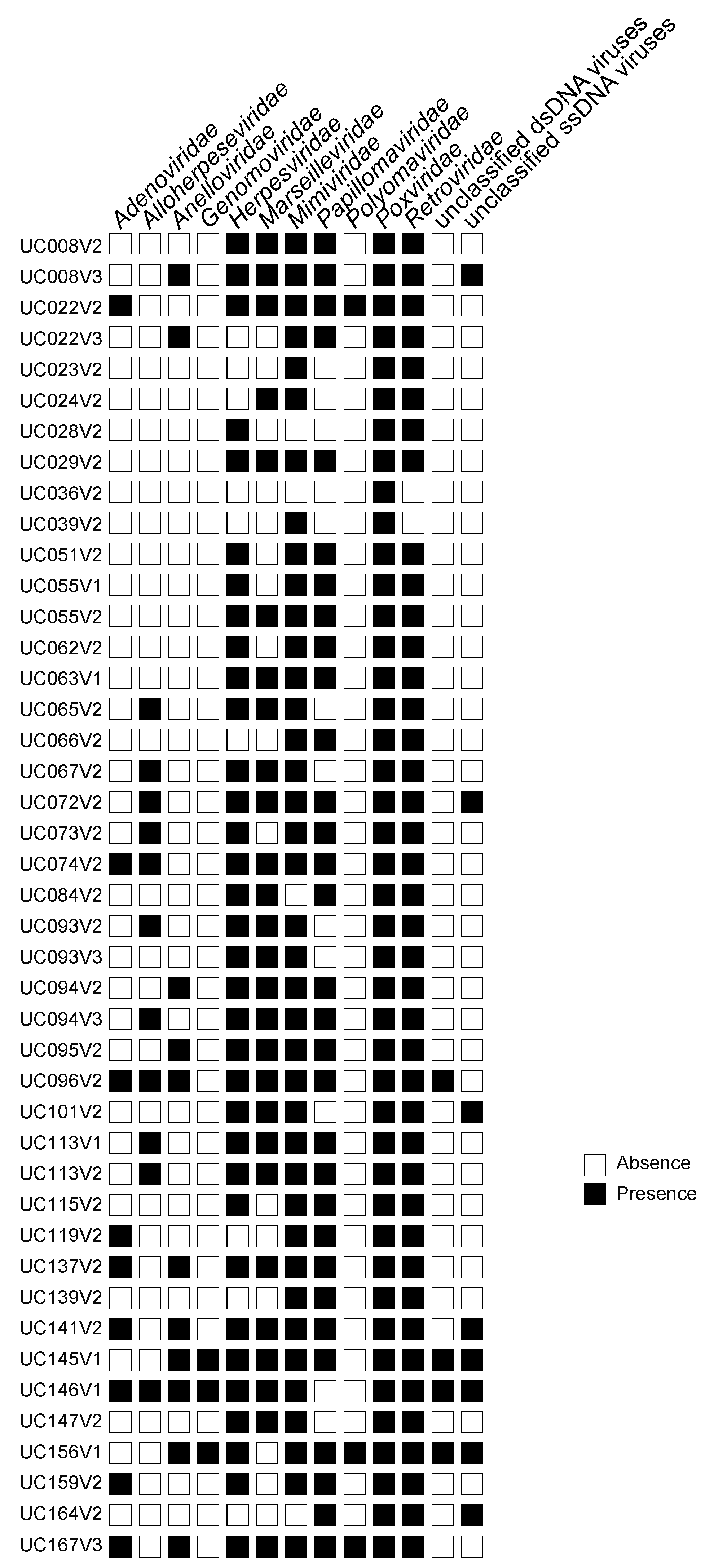
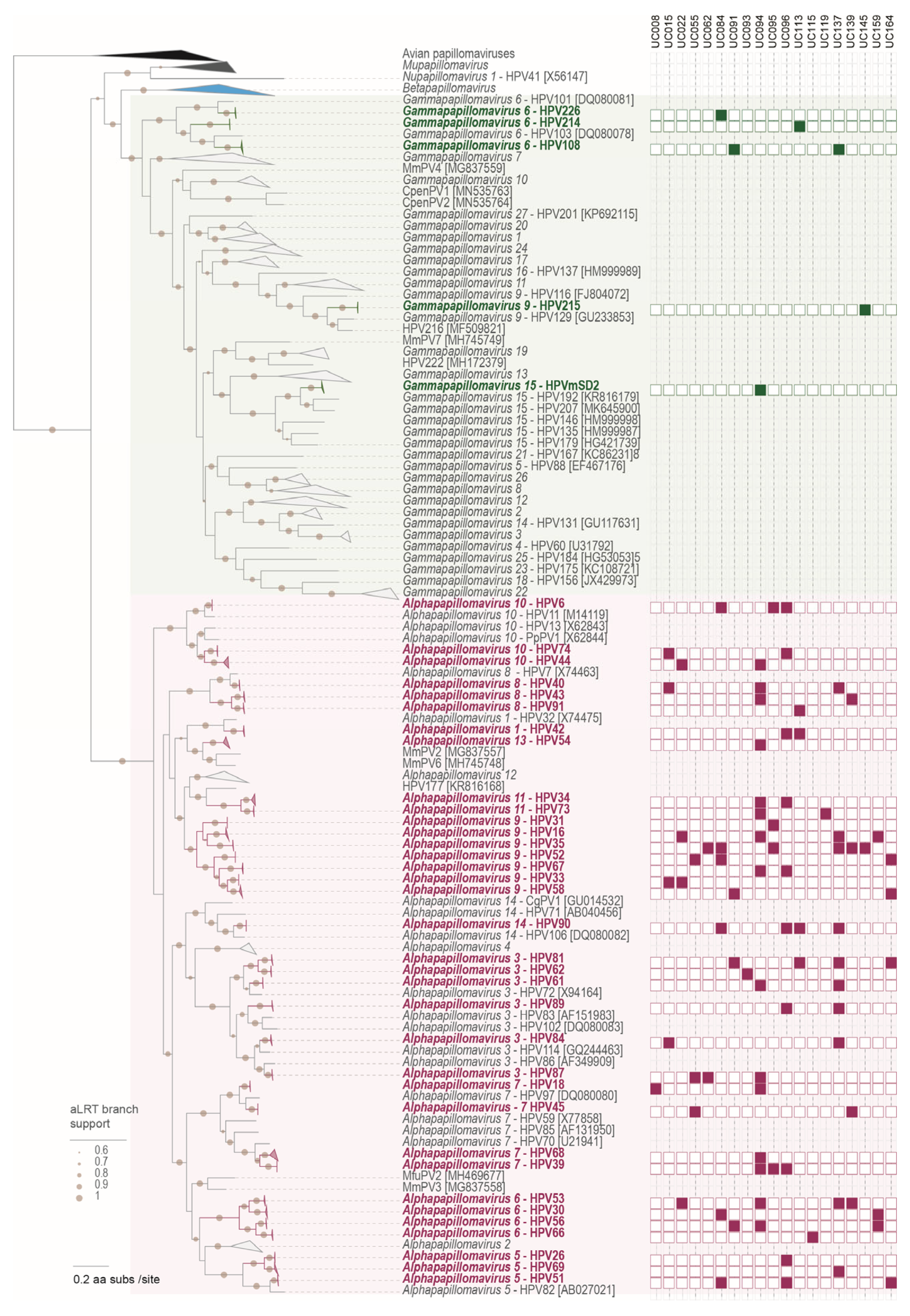
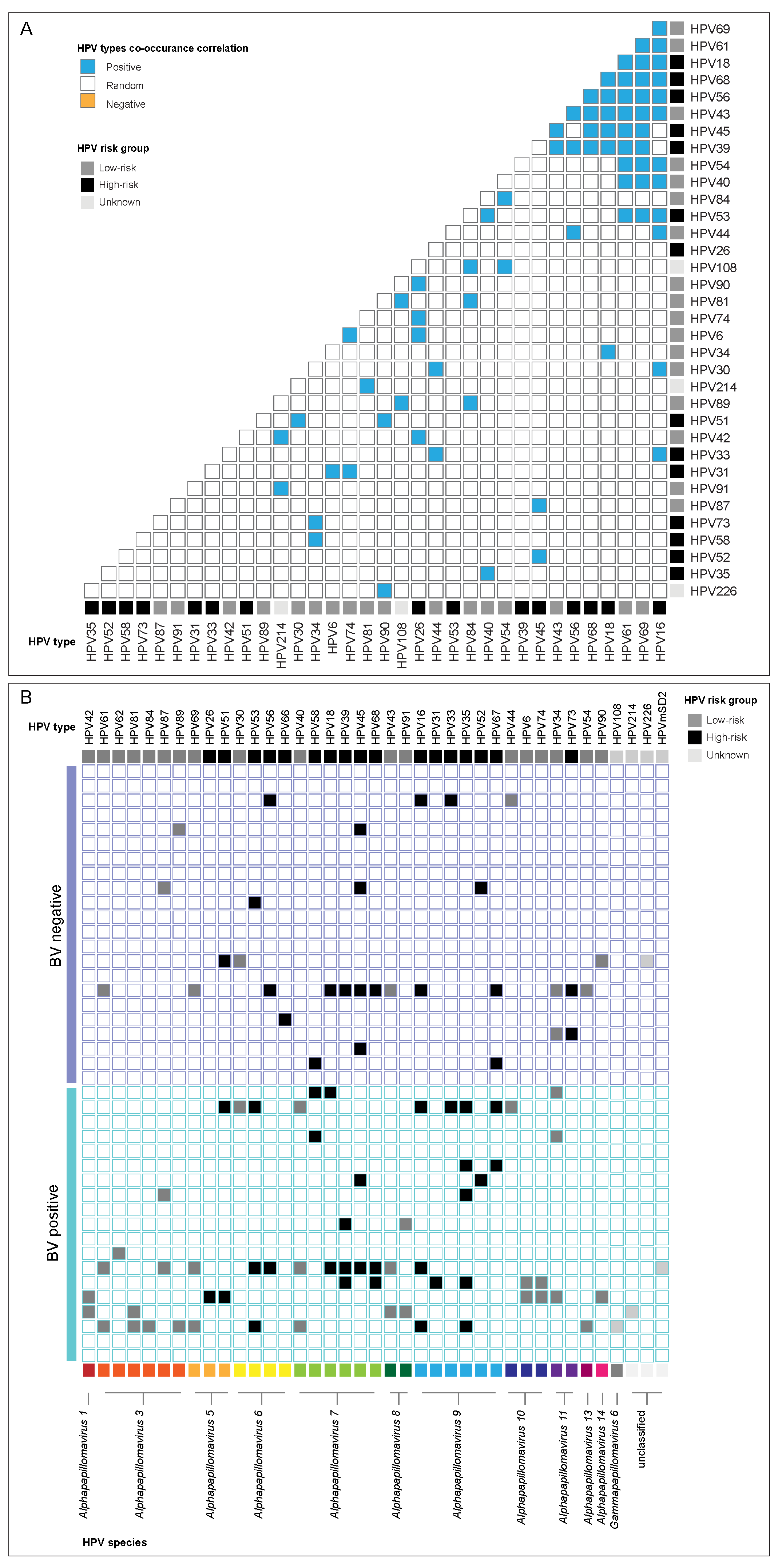
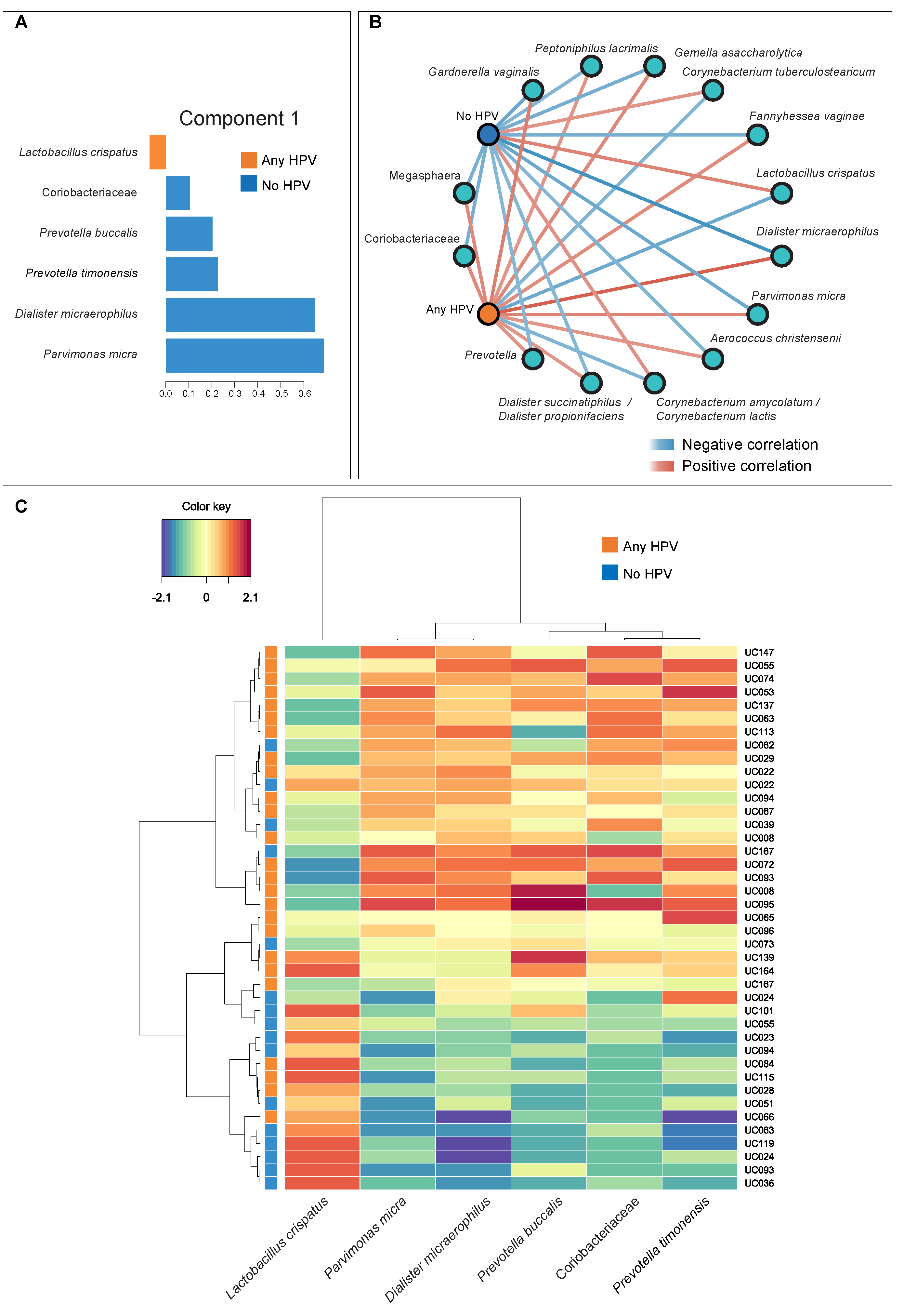
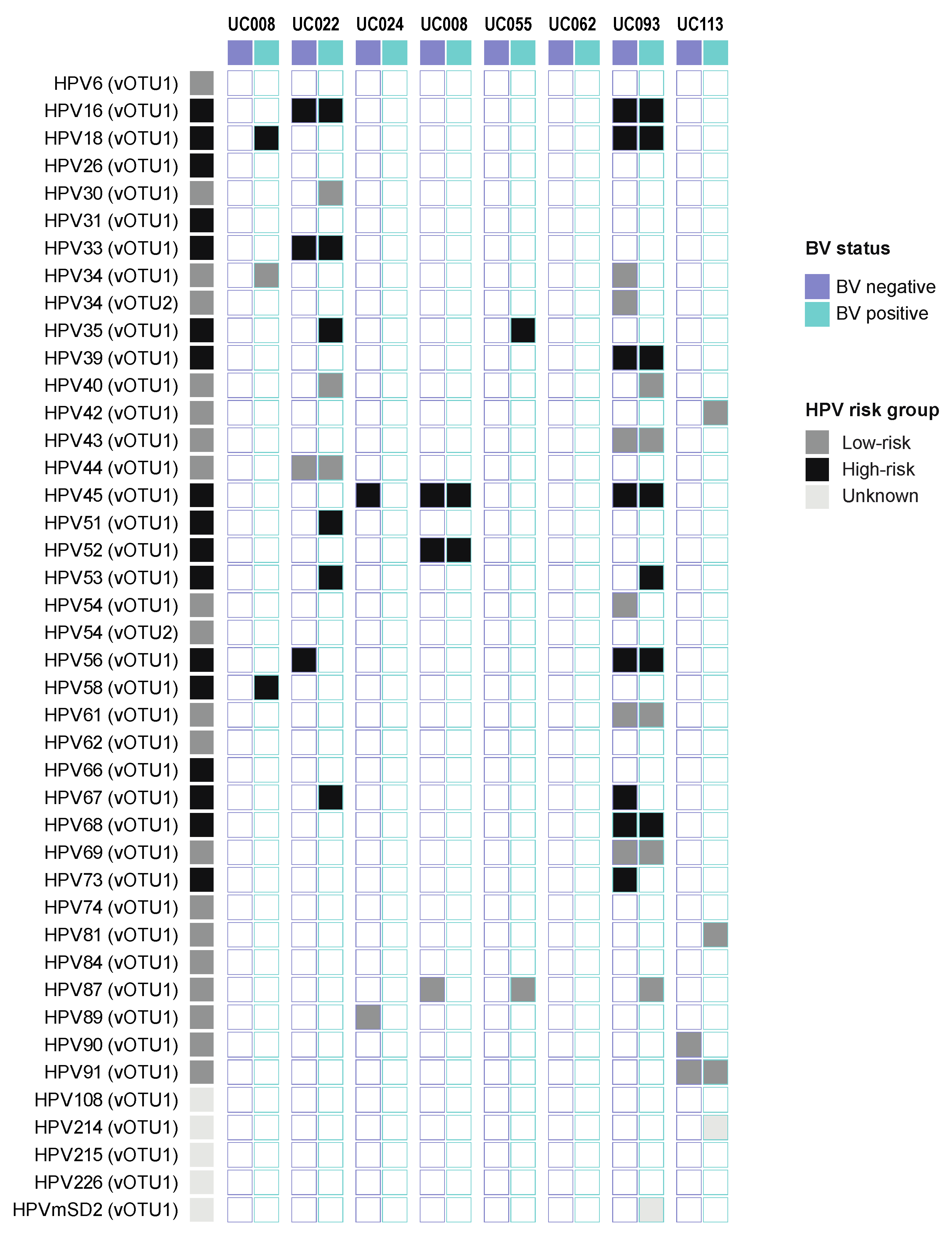
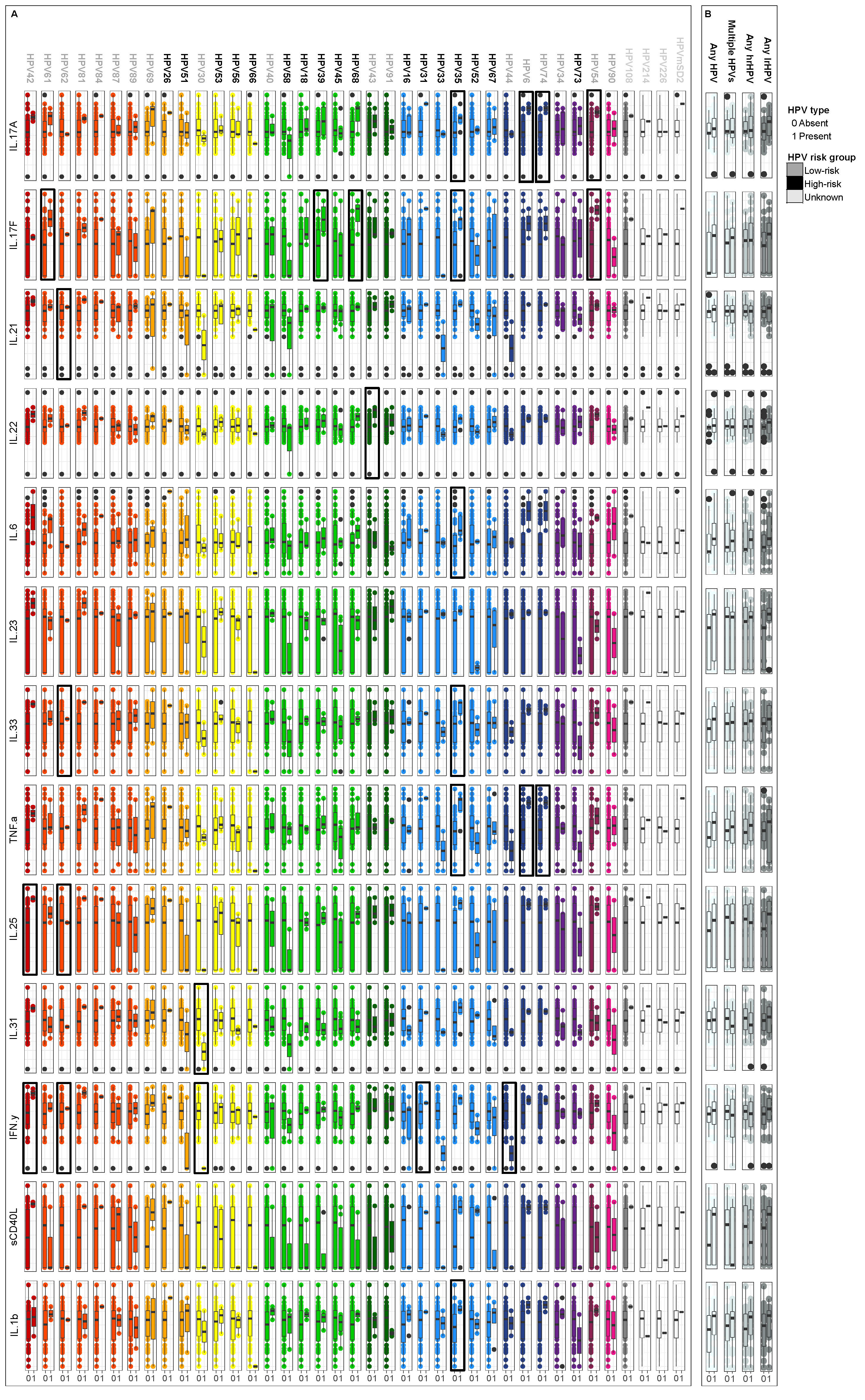
| All (n = 33) | BV − (n = 8) # | BV + (n = 8) # | p-Value # | |
|---|---|---|---|---|
| Age at screening, years [median (IQR)] | 16 (16–18) | 17 (15–18) | - | - |
| BMI [median (IQR)] | 24.6 (21.8–29.3) | 23.6 (22.5–26.2) | 24.5 (23.1–30.3) | 0.482 |
| Contraceptive use [n(%)] | data | data | data | |
| None | 1 (3.0) | 1 (12.5) | 0 (0) | >0.999 |
| Injectable | 11 (33.3) | 2 (25.0) | 2 (25.0) | >0.999 |
| COC | 7 (21.2) | 0 (0) | 5 (62.5) | 0.025 |
| Nuvaring® | 14 (42.4) | 5 (62.5) | 1 (12.5) | 0.119 |
| Vaginal pH [median (IQR)] | 4.6 (4.2–5.2) | 4.7 (4.2–5.0) | 4.7 (4.4–4.9) | 0.873 |
| Sexually-transmitted infections [n(%)] | ||||
| HSV-2 seroprevalence a | 10 (30.3) | 3 (37.5) | 3 (37.5) | >0.999 |
| N. gonorrhea | 0 (0) | 1 (12.5) | 0 (0) | >0.999 |
| C. trachomatis b | 4 (12.1) | 2 (25.0) | 1 (12.5) | >0.999 |
| M. genitalium b | 1 (3.0) | |||
| Any bacterial STI | 5 (15.1) | 3 (37.5) | 1 (12.5) | 0.569 |
| Candidiasis [n(%)] | 6 (18.2) | 4 (50.0) | 1 (12.5) | 0.282 |
| Nugent-BV [n(%)] | 12 (36.4) | 0 (0) | 8 (100) | 0.0002 |
| CST distribution [n(%)] | ||||
| CST-I | 9 (27.3) | 1 (12.5) | 0 (0) | >0.999 |
| CST-III | 9 (27.3) | 6 (75.0) | 0 (0) | 0.007 |
| CST-IV | 15 (45.5) | 1 (12.5) | 8 (100) | 0.0004 |
| Shannon diversity [mean (sd)] | 1.5 (0.5–1.8) | 0.6 (0.4–1.5) | 2.1 (1.6–2.2) | 0.032 |
| Sexual Risk Behavior | ||||
| Age sexual debut, years [median (IQR)] | 15 (14–16) | 15 (14–16) | - | - |
| Number of sexual partners [mean (SD)] c | 1 (0.3) | 1 (0) | 1 (0) | >0.999 |
| Participant unsure if partner has multiple partners [n(%)] d | 4 (13.3) | 2 (25.0) | 3 (37.5) | >0.999 |
| Condom use during last sex act [n(%)] d | 15 (50.0) | 5 (62.5) | 3 (37.5) | 0.619 |
| Number vaginal sex acts per week [mean (SD)] d | 0.9 (0.3) | 2 (1.2) | 2 (0.8) | >0.999 |
| Previously pregnant [n(%)] f | 2 (6.25) | 1 (12.5) | - | - |
| Virus Name | Genus | Species | Type | GenBank Accession |
|---|---|---|---|---|
| HPV6_UC095_LW_V2 | Alphapapillomavirus | Alphapapillomavirus 10 | human papillomavirus 6 | OP971086 |
| HPV6_UC096_LW_V2 | Alphapapillomavirus | Alphapapillomavirus 10 | human papillomavirus 6 | OP971088 |
| HPV6_UC084_LW_V1 | Alphapapillomavirus | Alphapapillomavirus 10 | human papillomavirus 6 | OP971006 |
| HPV6_UC084_LW_V2 | Alphapapillomavirus | Alphapapillomavirus 10 | human papillomavirus 6 | OP971011 |
| HPV6_UC096_LW_V3 | Alphapapillomavirus | Alphapapillomavirus 10 | human papillomavirus 6 | OP971026 |
| HPV16_UC022_LW_V2 | Alphapapillomavirus | Alphapapillomavirus 9 | human papillomavirus 16 | OP971070 |
| HPV16_UC094_LW_V2 | Alphapapillomavirus | Alphapapillomavirus 9 | human papillomavirus 16 | OP971046 |
| HPV16_UC094_LW_V3 | Alphapapillomavirus | Alphapapillomavirus 9 | human papillomavirus 16 | OP971080 |
| HPV16_UC137_LW_V2 | Alphapapillomavirus | Alphapapillomavirus 9 | human papillomavirus 16 | OP971062 |
| HPV16_UC159_LW_V2 | Alphapapillomavirus | Alphapapillomavirus 9 | human papillomavirus 16 | OP971067 |
| HPV18_UC008_LW_V3 | Alphapapillomavirus | Alphapapillomavirus 7 | human papillomavirus 18 | OP971042 |
| HPV18_UC094_LW_V2 | Alphapapillomavirus | Alphapapillomavirus 7 | human papillomavirus 18 | OP971048 |
| HPV18_UC094_LW_V3 | Alphapapillomavirus | Alphapapillomavirus 7 | human papillomavirus 18 | OP971083 |
| HPV26_UC096_LW_V2 | Alphapapillomavirus | Alphapapillomavirus 5 | human papillomavirus 26 | OP971091 |
| HPV30_UC159_LW_V2 | Alphapapillomavirus | Alphapapillomavirus 6 | human papillomavirus 30 | OP971102 |
| HPV30_UC084_LW_V1 | Alphapapillomavirus | Alphapapillomavirus 6 | human papillomavirus 30 | OP971007 |
| HPV30_UC084_LW_V2 | Alphapapillomavirus | Alphapapillomavirus 6 | human papillomavirus 30 | OP971013 |
| HPV31_UC095_LW_V2 | Alphapapillomavirus | Alphapapillomavirus 9 | human papillomavirus 31 | OP970964 |
| HPV33_UC022_LW_V2 | Alphapapillomavirus | Alphapapillomavirus 9 | human papillomavirus 33 | OP971069 |
| HPV33_UC015_LW_V1 | Alphapapillomavirus | Alphapapillomavirus 9 | human papillomavirus 33 | OP970997 |
| HPV34_UC094_LW_V2 | Alphapapillomavirus | Alphapapillomavirus 11 | human papillomavirus 34 | OP971076 |
| HPV34_UC096_LW_V2 | Alphapapillomavirus | Alphapapillomavirus 11 | human papillomavirus 34 | OP971093 |
| HPV34_UC084_LW_V1 | Alphapapillomavirus | Alphapapillomavirus 11 | human papillomavirus 34 | OP971009 |
| HPV35_UC062_LW_V2 | Alphapapillomavirus | Alphapapillomavirus 9 | human papillomavirus 35 | OP971043 |
| HPV35_UC095_LW_V2 | Alphapapillomavirus | Alphapapillomavirus 9 | human papillomavirus 35 | OP971054 |
| HPV35_UC137_LW_V2 | Alphapapillomavirus | Alphapapillomavirus 9 | human papillomavirus 35 | OP971063 |
| HPV35_UC145_LW_V1 | Alphapapillomavirus | Alphapapillomavirus 9 | human papillomavirus 35 | OP971100 |
| HPV35_UC139_LW_V2 | Alphapapillomavirus | Alphapapillomavirus 9 | human papillomavirus 35 | OP971032 |
| HPV35_UC139_LW_V3 | Alphapapillomavirus | Alphapapillomavirus 9 | human papillomavirus 35 | OP971034 |
| HPV39_UC094_LW_V2 | Alphapapillomavirus | Alphapapillomavirus 7 | human papillomavirus 39 | OP971074 |
| HPV39_UC094_LW_V3 | Alphapapillomavirus | Alphapapillomavirus 7 | human papillomavirus 39 | OP971084 |
| HPV39_UC095_LW_V2 | Alphapapillomavirus | Alphapapillomavirus 7 | human papillomavirus 39 | OP971087 |
| HPV39_UC096_LW_V1 | Alphapapillomavirus | Alphapapillomavirus 7 | human papillomavirus 39 | OP971024 |
| HPV40_UC094_LW_V3 | Alphapapillomavirus | Alphapapillomavirus 7 | human papillomavirus 40 | OP971079 |
| HPV40_UC137_LW_V2 | Alphapapillomavirus | Alphapapillomavirus 7 | human papillomavirus 40 | OP971061 |
| HPV40_UC015_LW_V3 | Alphapapillomavirus | Alphapapillomavirus 7 | human papillomavirus 40 | OP970999 |
| HPV42_UC096_LW_V2 | Alphapapillomavirus | Alphapapillomavirus 1 | human papillomavirus 42 | OP971089 |
| HPV42_UC113_LW_V2 | Alphapapillomavirus | Alphapapillomavirus 1 | human papillomavirus 42 | OP971098 |
| HPV42_UC096_LW_V3 | Alphapapillomavirus | Alphapapillomavirus 1 | human papillomavirus 42 | OP971027 |
| HPV43_UC094_LW_V2 | Alphapapillomavirus | Alphapapillomavirus 8 | human papillomavirus 43 | OP971044 |
| HPV43_UC094_LW_V3 | Alphapapillomavirus | Alphapapillomavirus 8 | human papillomavirus 43 | OP971078 |
| HPV43_UC139_LW_V1 | Alphapapillomavirus | Alphapapillomavirus 8 | human papillomavirus 43 | OP971030 |
| HPV44_UC022_LW_V2 | Alphapapillomavirus | Alphapapillomavirus 10 | human papillomavirus 44 | OP971071 |
| HPV45_UC094_LW_V2 | Alphapapillomavirus | Alphapapillomavirus 7 | human papillomavirus 45 | OP971072 |
| HPV45_UC094_LW_V3 | Alphapapillomavirus | Alphapapillomavirus 7 | human papillomavirus 45 | OP971081 |
| HPV45_UC055_LW_V2 | Alphapapillomavirus | Alphapapillomavirus 7 | human papillomavirus 45 | OP971003 |
| HPV45_UC139_LW_V2 | Alphapapillomavirus | Alphapapillomavirus 7 | human papillomavirus 45 | OP971033 |
| HPV51_UC096_LW_V2 | Alphapapillomavirus | Alphapapillomavirus 5 | human papillomavirus 51 | OP971092 |
| HPV51_UC084_LW_V1 | Alphapapillomavirus | Alphapapillomavirus 5 | human papillomavirus 51 | OP971008 |
| HPV51_UC084_LW_V2 | Alphapapillomavirus | Alphapapillomavirus 5 | human papillomavirus 51 | OP971014 |
| HPV51_UC164_LW_V1 | Alphapapillomavirus | Alphapapillomavirus 5 | human papillomavirus 51 | OP971038 |
| HPV52_UC055_LW_V1 | Alphapapillomavirus | Alphapapillomavirus 9 | human papillomavirus 52 | OP971002 |
| HPV52_UC084_LW_V2 | Alphapapillomavirus | Alphapapillomavirus 9 | human papillomavirus 52 | OP971012 |
| HPV52_UC164_LW_V1 | Alphapapillomavirus | Alphapapillomavirus 9 | human papillomavirus 52 | OP971036 |
| HPV52_UC164_LW_V2 | Alphapapillomavirus | Alphapapillomavirus 9 | human papillomavirus 52 | OP971039 |
| HPV52_UC164_LW_V3 | Alphapapillomavirus | Alphapapillomavirus 9 | human papillomavirus 52 | OP971041 |
| HPV53_UC022_LW_V3 | Alphapapillomavirus | Alphapapillomavirus 6 | human papillomavirus 53 | OP970965 |
| HPV53_UC094_LW_V3 | Alphapapillomavirus | Alphapapillomavirus 6 | human papillomavirus 53 | OP971053 |
| HPV53_UC137_LW_V2 | Alphapapillomavirus | Alphapapillomavirus 6 | human papillomavirus 53 | OP971099 |
| HPV53_UC139_LW_V1 | Alphapapillomavirus | Alphapapillomavirus 6 | human papillomavirus 53 | OP971031 |
| HPV54_UC094_LW_V2 | Alphapapillomavirus | Alphapapillomavirus 13 | human papillomavirus 54 | OP971049 |
| HPV54_UC137_LW_V2 | Alphapapillomavirus | Alphapapillomavirus 13 | human papillomavirus 54 | OP971064 |
| HPV56_UC094_LW_V2 | Alphapapillomavirus | Alphapapillomavirus 6 | human papillomavirus 56 | OP971047 |
| HPV56_UC159_LW_V2 | Alphapapillomavirus | Alphapapillomavirus 6 | human papillomavirus 56 | OP971068 |
| HPV56_UC091_LW_V1 | Alphapapillomavirus | Alphapapillomavirus 6 | human papillomavirus 56 | OP971017 |
| HPV56_UC091_LW_V2 | Alphapapillomavirus | Alphapapillomavirus 6 | human papillomavirus 56 | OP971020 |
| HPV58_UC091_LW_V1 | Alphapapillomavirus | Alphapapillomavirus 9 | human papillomavirus 58 | OP971016 |
| HPV58_UC164_LW_V1 | Alphapapillomavirus | Alphapapillomavirus 9 | human papillomavirus 58 | OP971037 |
| HPV58_UC164_LW_V2 | Alphapapillomavirus | Alphapapillomavirus 9 | human papillomavirus 58 | OP971040 |
| HPV61_UC094_LW_V2 | Alphapapillomavirus | Alphapapillomavirus 3 | human papillomavirus 61 | OP971045 |
| HPV61_UC094_LW_V3 | Alphapapillomavirus | Alphapapillomavirus 3 | human papillomavirus 61 | OP971077 |
| HPV61_UC137_LW_V2 | Alphapapillomavirus | Alphapapillomavirus 3 | human papillomavirus 61 | OP971059 |
| HPV62_UC093_LW_V1 | Alphapapillomavirus | Alphapapillomavirus 3 | human papillomavirus 62 | OP971022 |
| HPV66_UC115_LW_V3 | Alphapapillomavirus | Alphapapillomavirus 6 | human papillomavirus 66 | OP971029 |
| HPV67_UC094_LW_V2 | Alphapapillomavirus | Alphapapillomavirus 9 | human papillomavirus 67 | OP971075 |
| HPV67_UC096_LW_V1 | Alphapapillomavirus | Alphapapillomavirus 9 | human papillomavirus 67 | OP971025 |
| HPV68_UC094_LW_V2 | Alphapapillomavirus | Alphapapillomavirus 7 | human papillomavirus 68 | OP971073 |
| HPV68_UC094_LW_V3 | Alphapapillomavirus | Alphapapillomavirus 7 | human papillomavirus 68 | OP971082 |
| HPV69_UC094_LW_V2 | Alphapapillomavirus | Alphapapillomavirus 5 | human papillomavirus 69 | OP971051 |
| HPV69_UC094_LW_V3 | Alphapapillomavirus | Alphapapillomavirus 5 | human papillomavirus 69 | OP971085 |
| HPV69_UC137_LW_V2 | Alphapapillomavirus | Alphapapillomavirus 5 | human papillomavirus 69 | OP971065 |
| HPV73_UC094_LW_V2 | Alphapapillomavirus | Alphapapillomavirus 11 | human papillomavirus 73 | OP971050 |
| HPV73_UC119_LW_V2 | Alphapapillomavirus | Alphapapillomavirus 11 | human papillomavirus 73 | OP971057 |
| HPV74_UC096_LW_V2 | Alphapapillomavirus | Alphapapillomavirus 10 | human papillomavirus 74 | OP971090 |
| HPV74_UC015_LW_V3 | Alphapapillomavirus | Alphapapillomavirus 10 | human papillomavirus 74 | OP971000 |
| HPV74_UC096_LW_V3 | Alphapapillomavirus | Alphapapillomavirus 10 | human papillomavirus 74 | OP971028 |
| HPV81_UC113_LW_V2 | Alphapapillomavirus | Alphapapillomavirus 3 | human papillomavirus 81 | OP971096 |
| HPV81_UC091_LW_V2 | Alphapapillomavirus | Alphapapillomavirus 3 | human papillomavirus 81 | OP971019 |
| HPV81_UC091_LW_V3 | Alphapapillomavirus | Alphapapillomavirus 3 | human papillomavirus 81 | OP971021 |
| HPV81_UC137_LW_V2 | Alphapapillomavirus | Alphapapillomavirus 3 | human papillomavirus 81 | OP970966 |
| HPV81_UC164_LW_V1 | Alphapapillomavirus | Alphapapillomavirus 3 | human papillomavirus 81 | OP971035 |
| HPV84_UC137_LW_V2 | Alphapapillomavirus | Alphapapillomavirus 3 | human papillomavirus 84 | OP971060 |
| HPV84_UC015_LW_V3 | Alphapapillomavirus | Alphapapillomavirus 3 | human papillomavirus 84 | OP970998 |
| HPV87_UC094_LW_V3 | Alphapapillomavirus | Alphapapillomavirus 3 | human papillomavirus 87 | OP971052 |
| HPV87_UC055_LW_V1 | Alphapapillomavirus | Alphapapillomavirus 3 | human papillomavirus 87 | OP971001 |
| HPV87_UC062_LW_V3 | Alphapapillomavirus | Alphapapillomavirus 3 | human papillomavirus 87 | OP971004 |
| HPV89_UC137_LW_V2 | Alphapapillomavirus | Alphapapillomavirus 3 | human papillomavirus 89 | OP971058 |
| HPV89_UC096_LW_V1 | Alphapapillomavirus | Alphapapillomavirus 3 | human papillomavirus 89 | OP971023 |
| HPV90_UC096_LW_V2 | Alphapapillomavirus | Alphapapillomavirus 14 | human papillomavirus 90 | OP971055 |
| HPV90_UC113_LW_V1 | Alphapapillomavirus | Alphapapillomavirus 14 | human papillomavirus 90 | OP971094 |
| HPV90_UC084_LW_V1 | Alphapapillomavirus | Alphapapillomavirus 14 | human papillomavirus 90 | OP971005 |
| HPV90_UC084_LW_V2 | Alphapapillomavirus | Alphapapillomavirus 14 | human papillomavirus 90 | OP971010 |
| HPV91_UC113_LW_V1 | Alphapapillomavirus | Alphapapillomavirus 8 | human papillomavirus 91 | OP971095 |
| HPV91_UC113_LW_V2 | Alphapapillomavirus | Alphapapillomavirus 8 | human papillomavirus 91 | OP971097 |
| HPV108_UC137_LW_V2 | Gammapapillomavirus | Gammapapillomavirus 6 | human papillomavirus 108 | OP971066 |
| HPV108_UC091_LW_V1 | Gammapapillomavirus | Gammapapillomavirus 6 | human papillomavirus 108 | OP971018 |
| HPV214_UC113_LW_V2 | Gammapapillomavirus | unclassified | human papillomavirus 214 | OP971056 |
| HPV215_UC145_LW_V1 | Gammapapillomavirus | unclassified | human papillomavirus 215 | OP971101 |
| HPV226_UC084_LW_V2 | Gammapapillomavirus | unclassified | human papillomavirus 226 | OP971015 |
| HPVmSD2_UC094_LW_V3 | Gammapapillomavirus | unclassified | human papillomavirus mSD2 | OP970967 |
| Cytokine | Any HPV | Multiple HPVs | Any High-Risk HPV | Any Low-Risk HPV | Bacterial Vaginosis | |||||
|---|---|---|---|---|---|---|---|---|---|---|
| Beta-Estimate (95% CI) | p | Beta-Estimate (95% CI) | p | Beta-Estimate (95% CI) | p | Beta-Estimate (95% CI) | p | Beta-Estimate (95% CI) | p | |
| IL-1β | 0.20 (−0.36; 0.77) | 0.483 | −0.41 (−1.22; 0.39) | 0.312 | 0.04 (−0.53; 0.62) | 0.895 | −0.03 (−0.61; 0.55) | 0.921 | 1.00 (0.30; 1.69) | 0.006 |
| IL-6 | 0.28 (−0.59; 1.16) | 0.517 | −0.42 (1.45; 0.62) | 0.430 | −0.16 (−1.02; 0.71) | 0.726 | 0.50 (−0.38; 1.37) | 0.268 | 0.61 (−0.18; 1.40) | 0.134 |
| IL-17A | 0.42 (−1.01; 1.85) | 0.565 | −0.48 (−2.12; 1.17) | 0.569 | −0.06 (−1.49; 1.36) | 0.930 | 1.15 (−0.52; 2.84) | 0.178 | 0.46 (−0.82; 1.75) | 0.478 |
| IL-17F | 0.48 (−0.47; 1.42) | 0.322 | −0.33 (−1.33; 0.67) | 0.518 | 0.11 (−0.79; 1.01) | 0.812 | 0.35 (−0.55; 1.25) | 0.447 | 0.82 (0.01; 1.64) | 0.048 |
| IL-21 | 0.03 (−0.32; 1.33) | 0.978 | −0.05 (−0.79; 0.68) | 0.884 | 0.03 (−0.64; 0.71) | 0.927 | 0.24 (−0.46; 0.95) | 0.508 | 0.11 (−0.47; 0.71) | 0.707 |
| IL-22 | 0.17 (−1.28; 1.62) | 0.817 | −1.48 (−3.76; 0.79) | 0.200 | −0.52 (−2.11, 1.07) | 0.523 | 0.34 (−1.08; 1.75) | 0.641 | 0.28 (−1.02; 1.57) | 0.676 |
| IL-23 | 0.28 (−0.52; 1.08) | 0.491 | −0.34 (1.20; 0.52) | 0.435 | −0.16 (−0.95; 0.62) | 0.683 | 0.65 (−0.31; 1.62) | 0.185 | 0.69 (−0.04; 1.42) | 0.063 |
| IL-25 | 0.08 (−0.65; 0.81) | 0.825 | −0.59 (−1.38; 0.21) | 0.149 | −0.33 (−1.04; 0.37) | 0.353 | 0.12 (−0.60; 0.84) | 0.741 | 0.68 (0.03; 1.33) | 0.041 |
| IL-31 | −0.53 (−2.15; 1.08) | 0.517 | −1.75 (−3.81; 0.30) | 0.094 | −1.33 (−3.06; 0.40) | 0.132 | 0.52 (−1.03; 2.07) | 0.510 | 0.81 (−0.56; 2.18) | 0.249 |
| IL-33 | 0.27 (−0.92; 1.45) | 0.661 | −0.43 (−1.72; 0.84) | 0.502 | −0.42 (−1.60; 0.76) | 0.486 | 0.61 (−0.68; 1.90) | 0.355 | 1.34 (0.12; 2.57) | 0.032 |
| IFN-γ | −0.50 (−1.92; 0.91) | 0.484 | −1.60 (−3.27; 0.07) | 0.061 | −1.22 (−2.76; 0.31) | 0.118 | 0.06 (−1.22; 1.34) | 0.928 | 1.10 (−0.22; 2.43) | 0.103 |
| sCD40L | 0.08 (−0.61; 0.76) | 0.828 | −0.47 (−1.26; 0.32) | 0.240 | −0.31 (−1.01, 0.39) | 0.390 | −0.07 (−0.72; 0.59) | 0.838 | 0.34 (−0.23; 0.96) | 0.223 |
| TNF-α | 0.26 (−0.58; 1.10) | 0.552 | −0.58 (−1.54; 0.38) | 0.236 | −0.11 (−0.92; 0.70) | 0.788 | −0.24 (−1.06; 0.58) | 0.560 | 1.60 (0.52; 2.68) | 0.004 |
Disclaimer/Publisher’s Note: The statements, opinions and data contained in all publications are solely those of the individual author(s) and contributor(s) and not of MDPI and/or the editor(s). MDPI and/or the editor(s) disclaim responsibility for any injury to people or property resulting from any ideas, methods, instructions or products referred to in the content. |
© 2023 by the authors. Licensee MDPI, Basel, Switzerland. This article is an open access article distributed under the terms and conditions of the Creative Commons Attribution (CC BY) license (https://creativecommons.org/licenses/by/4.0/).
Share and Cite
Happel, A.-U.; Balle, C.; Havyarimana, E.; Brown, B.; Maust, B.S.; Feng, C.; Yi, B.H.; Gill, K.; Bekker, L.-G.; Passmore, J.-A.S.; et al. Cervicovaginal Human Papillomavirus Genomes, Microbiota Composition and Cytokine Concentrations in South African Adolescents. Viruses 2023, 15, 758. https://doi.org/10.3390/v15030758
Happel A-U, Balle C, Havyarimana E, Brown B, Maust BS, Feng C, Yi BH, Gill K, Bekker L-G, Passmore J-AS, et al. Cervicovaginal Human Papillomavirus Genomes, Microbiota Composition and Cytokine Concentrations in South African Adolescents. Viruses. 2023; 15(3):758. https://doi.org/10.3390/v15030758
Chicago/Turabian StyleHappel, Anna-Ursula, Christina Balle, Enock Havyarimana, Bryan Brown, Brandon S. Maust, Colin Feng, Byung H. Yi, Katherine Gill, Linda-Gail Bekker, Jo-Ann S. Passmore, and et al. 2023. "Cervicovaginal Human Papillomavirus Genomes, Microbiota Composition and Cytokine Concentrations in South African Adolescents" Viruses 15, no. 3: 758. https://doi.org/10.3390/v15030758
APA StyleHappel, A.-U., Balle, C., Havyarimana, E., Brown, B., Maust, B. S., Feng, C., Yi, B. H., Gill, K., Bekker, L.-G., Passmore, J.-A. S., Jaspan, H. B., & Varsani, A. (2023). Cervicovaginal Human Papillomavirus Genomes, Microbiota Composition and Cytokine Concentrations in South African Adolescents. Viruses, 15(3), 758. https://doi.org/10.3390/v15030758








